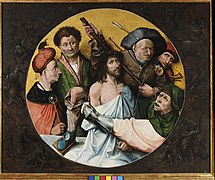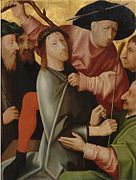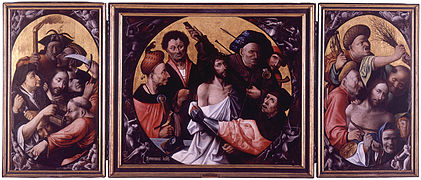
The Adoration of the Magi or Adoration of the Kings or Visitation of the Wise Men is the name traditionally given to the subject in the Nativity of Jesus in art in which the three Magi, represented as kings, especially in the West, having found Jesus by following a star, lay before him gifts of gold, frankincense, and myrrh, and worship him. It is related in the Bible by Matthew 2:11: "On entering the house, they saw the child with Mary his mother; and they knelt down and paid him homage. Then, opening their treasure chests, they offered him gifts of gold, frankincense, and myrrh. And having been warned in a dream not to return to Herod, they left for their own country by another path".

Ship of Fools is a painting by Hieronymus Bosch, now in the Musée du Louvre, Paris. Camille Benoit donated it in 1918. The Louvre restored it in 2015. The surviving painting is a fragment of a triptych that was cut into several parts. The Ship of Fools was painted on one of the wings of the altarpiece, and is about two-thirds of its original length. The bottom third of the panel belongs to Yale University Art Gallery and is exhibited under the title Allegory of Gluttony. The other wing, which has more or less retained its full length, is the Death and the Miser, now in the National Gallery of Art, Washington, D.C. The two panels together would have represented the two extremes of prodigality and miserliness, condemning and caricaturing both. The Wayfarer (Rotterdam) was painted on the right panel rear of the triptych. The central panel, if it existed, is unknown.

Ecce homo are the Latin words used by Pontius Pilate in the Vulgate translation of the Gospel of John, when he presents a scourged Jesus, bound and crowned with thorns, to a hostile crowd shortly before his Crucifixion. The original New Testament Greek: "ἰδοὺ ὁ ἄνθρωπος", romanized: "idoù ho ánthropos", is rendered by most English Bible translations, e.g. the Douay-Rheims Bible and the King James Version, as "behold the man". The scene has been widely depicted in Christian art.

The Seven Deadly Sins and the Four Last Things is a painting attributed to Hieronymus Bosch or to a follower of his, completed around 1500 or later. Since 1898 its authenticity has been questioned several times. In 2015 the Bosch Research Conservation Project claimed it to be by a follower, but scholars at the Prado, where the painting is on display in a sealed case, dismissed this argument. The painting is oil on wooden panels and is presented in a series of circular images.
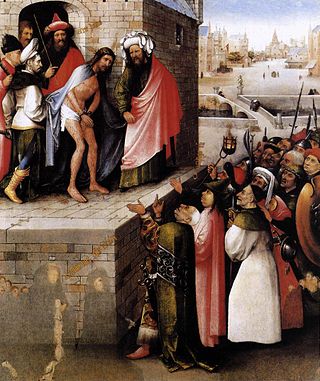
Ecce Homo is a painting of the episode in the Passion of Jesus by the Early Netherlandish painter Hieronymus Bosch, painted between 1475 and 1485. The original version, with a provenance in collections in Ghent, is in the Städel Museum in Frankfurt; a copy is held the Museum of Fine Arts in Boston. The painting takes its title from the Latin words Ecce Homo, "Behold the Man" spoken by the Roman Prefect Pontius Pilate when Jesus is paraded before a baying, angry mob in Jerusalem before he is sentenced to be crucified.
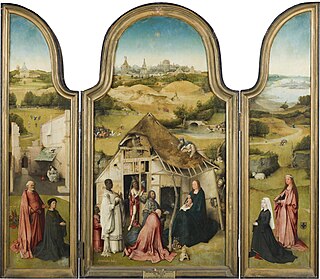
The Adoration of the Magi or The Epiphany is a triptych oil painting on wood panel by the Netherlandish artist Hieronymus Bosch, executed around 1485–1500. It is now in the Museo del Prado in Madrid, Spain.

Christ Carrying the Cross is a painting attributed to a follower of Hieronymus Bosch. It was painted in the early 16th century, presumably between 1510 and 1535. The work is housed in the Museum of Fine Arts in Ghent, Belgium. The painting is notable for its use of caricature to provide grotesque-looking faces surrounding Jesus.

Christ Crowned with Thorns is an oil on panel painting made in the 1530s by a follower of Hieronymus Bosch. It is now in the Monasterio de San Lorenzo at El Escorial, near Madrid, in Spain.
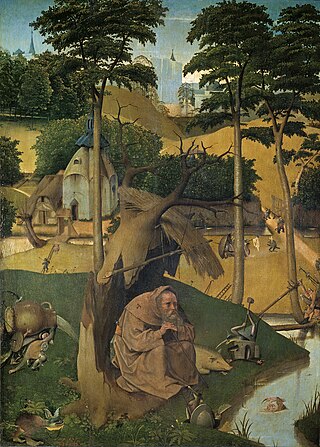
The Temptation of St. Anthony is a painting of disputed authorship, attributed to either Hieronymus Bosch or a follower. It is now in the Museo del Prado, in Madrid.

Gillis Mostaert the Elder was a Flemish Renaissance painter and draughtsman active in Antwerp in the second half of the 16th century. He was a versatile artist who worked in various genres including landscape, genre and history painting. Gillis Mostaert was known in particular for his winter landscapes and his scenes with fires and nocturnal scenes and his works in this genre were among the most sought after pieces of his time. The artist operated a large workshop in Antwerp, which supplied works to prominent patrons. He was a regular collaborator with leading Antwerp artists of his time.
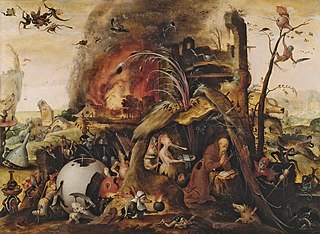
Jan Mandijn or Jan Mandyn was a Renaissance painter of the Low Countries, who worked in Antwerp after 1530. He is known for his works with subject matter and style reminiscent of Hieronymus Bosch.

Concert in the Egg is a painting formerly considered to be a copy of a lost work by Hieronymus Bosch, and which is currently considered to be based on one of his drawings. Max Jakob Friedländer called it 'an old copy', without specifying another work it was copied from.

The Triptych of Temptation of St. Anthony is an oil painting on wood panels by the Early Netherlandish painter Hieronymus Bosch, dating from around 1501. The work portrays the mental and spiritual torments endured by Saint Anthony the Great, one of the most prominent of the Desert Fathers of Egypt in the late 3rd and early 4th centuries. The Temptation of St. Anthony was a popular subject in Medieval and Renaissance art. In common with many of Bosch's works, the triptych contains much fantastic imagery. The painting hangs in the Museu Nacional de Arte Antiga in Lisbon.

The Exposition des primitifs flamands à Bruges was an art exhibition of paintings by the so-called Flemish Primitives held in the Provinciaal Hof in Bruges between 15 June and 5 October 1902.

Frans Verbeeck or Frans Verbeeck the Elder was a Flemish painter and draughtsman to whom have been attributed a number of works depicting fantastical and grotesque scenes carrying a moralizing intent. He was a member of an important family of artists operating a large workshop with various branches in Mechelen. As it is not always possible to attribute a particular artwork to one or the other family member due to compositional, stylistic, and iconographic similarities, it has been suggested that the works should be attributed to the 'Verbeeck group'. The works were typically executed in tempera or watercolor on linen.
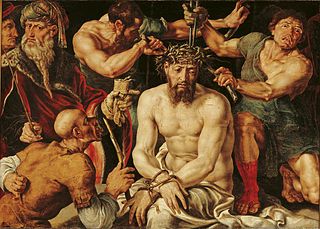
Christ Crowned with Thorns is a c. 1550 painting by the Dutch painter Maarten van Heemskerck in the collection of the Frans Hals Museum, in Haarlem.
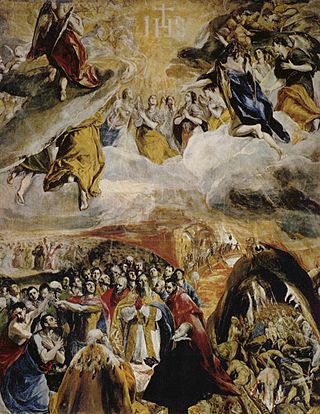
Adoration of the Holy Name of Jesus is a 1577-1579 oil on canvas painting by El Greco, produced early in his Toledo period and now in the Monasterio de El Escorial in Madrid. It is also known in modern scholarship as La Gloria, The Dream of Philip II or Allegory of the Holy League.

Pietà is a c. 1600 oil on canvas painting by Annibale Carracci, the earliest surviving work by him on the subject, which was commissioned by Odoardo Farnese. It moved from Rome to Parma to Naples as part of the Farnese collection and is now in the National Museum of Capodimonte in Naples. It is one of many 16th century Bolognese paintings dedicated to the theme of the Pietà, and it is counted among Carracci's masterpieces.
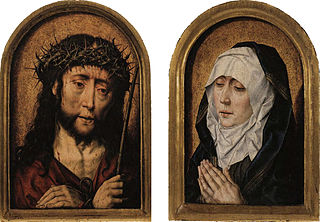
The Ecce Homo and Mater Dolorosa Diptych consisted of two small oil-on-panel paintings usually attributed to the Early Netherlandish artist Aelbrecht Bouts produced between 1491 – 1520. For many years they formed the wings of a hinged devotional diptych, but are now broken apart. Although their exact dating is unknown, the Ecce Homo panel, portraying Jesus bound and crowned with thorns, is thought to have been painted after 1491, while the Mater Dolorosa panel presents the Virgin Mary as Our Lady of Sorrows, and was painted after 1517. Both panels measure 45.5 x 31 cm, although the Mater Dolorosa is slightly larger at 31.1 cm wide. They are in the collection of the Suermondt-Ludwig-Museum, Aachen, Germany, where they are hung alongside each other.

Jesus Insulted by the Soldiers is an 1865 oil on canvas painting by Édouard Manet, his last religious work. It is now in the Art Institute of Chicago, to which it was left in 1925 by James Deering, heir to the Deering Harvester Company.

